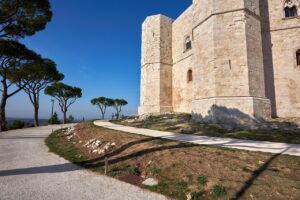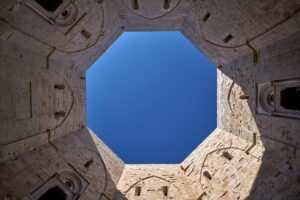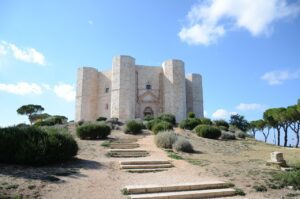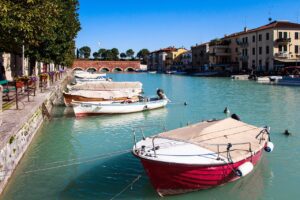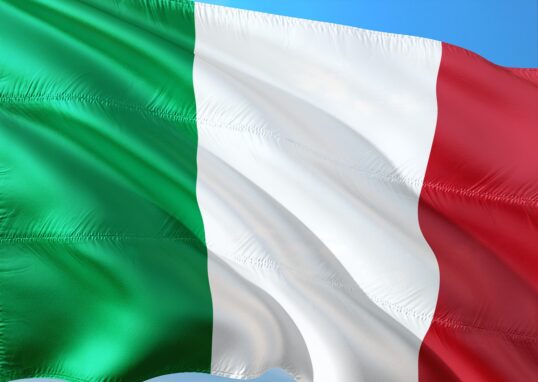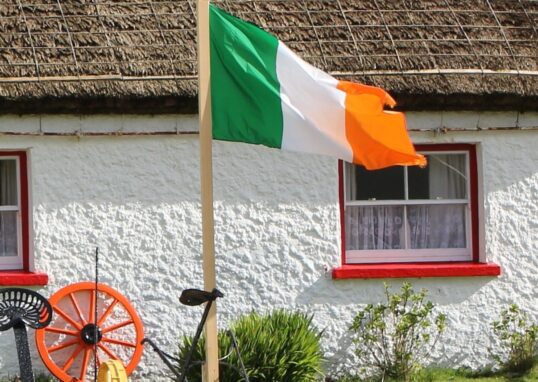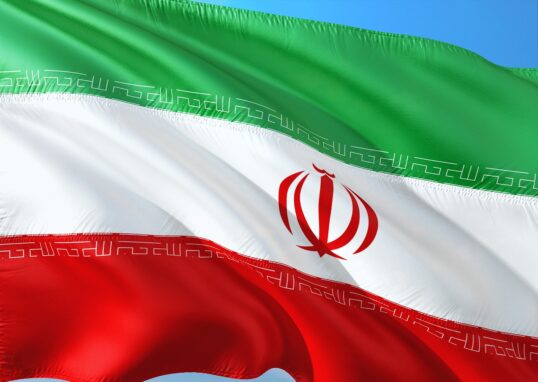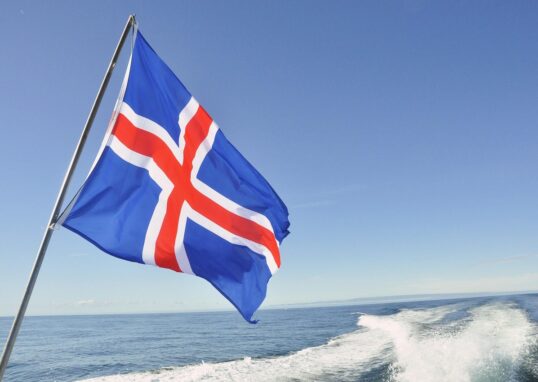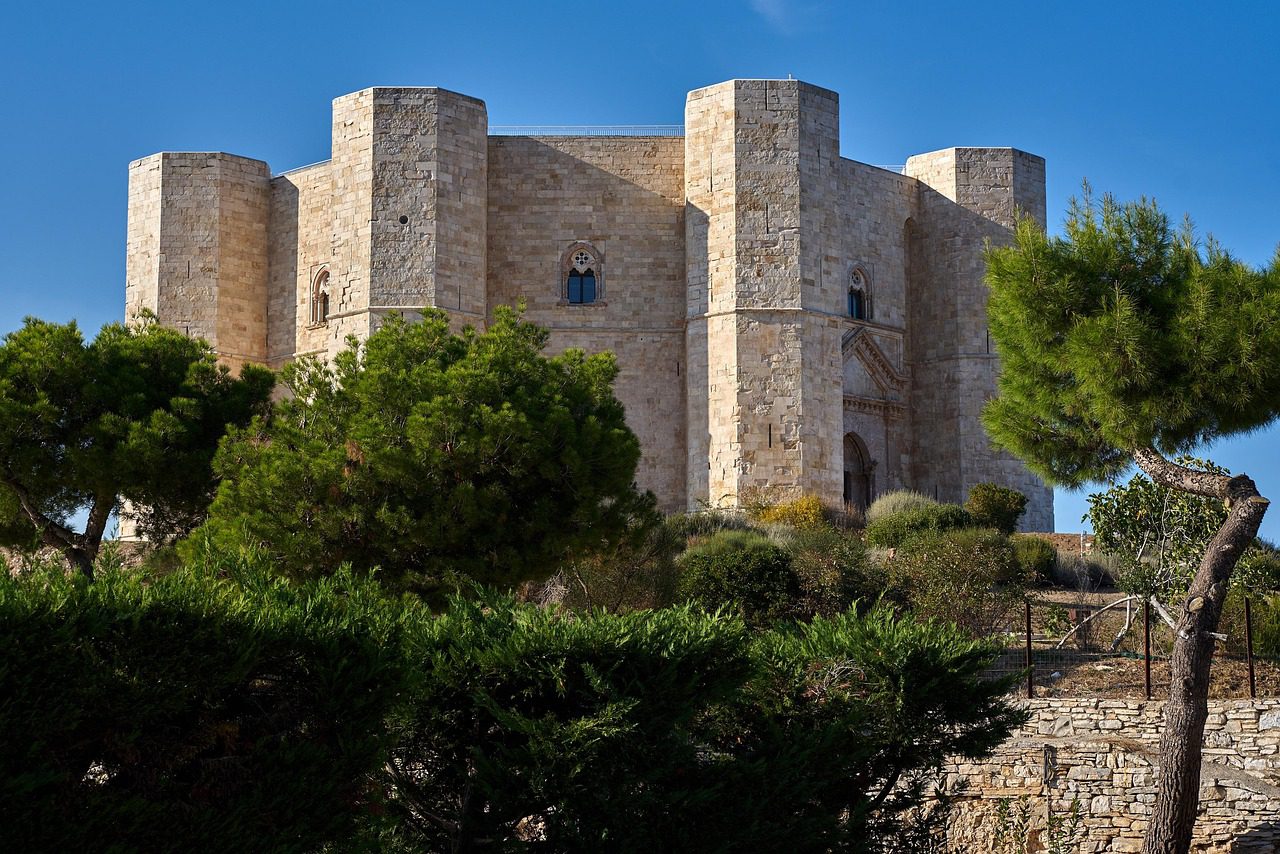
🏰 Castel del Monte – The Crown of Apulia, Italy
Castel del Monte is Italy’s most fascinating and mysterious castle. It stands triumphantly on a rolling hill in the Apulia (Puglia) region, in southern Italy. Its name means “Castle of the Mountain.” It overlooks the plains lying immediately outside the town of Andria, close to the Adriatic Sea. This magnificent monument was built in the 13th century by Emperor Frederick II, who ruled the Holy Roman Empire and the Kingdom of Sicily. Castel del Monte is a UNESCO World Heritage Site for its unique design, perfect geometry, and colossal cultural importance. Though it seems to be a fortress, Castel del Monte has no defensive moat, drawbridge, and apparent military function. Its purpose is something of a mystery, which adds to its charm and mystique.
Historical Background
The Vision of Emperor Frederick II
Frederick II, also called “Stupor Mundi” (Wonder of the World), started his rule as one of the most capable and educated rulers of the Middle Ages. Science, art, astronomy, and architecture interested him. He wanted to build structures that reflected his knowledge and conception of the world. Sometime around 1240, he ordered the construction of Castel del Monte atop an existing fortress. The location was well chosen — the castle lies on a hill around 540 meters above sea level, with far views of the countryside and Adriatic coast. The mathematical perfection of the castle indicates Frederick’s affection for astronomy and mathematics. Everything in the building seems to be controlled by a secret code. It is regarded as most historians’ symbol of harmony between heaven and earth.
The Mystery of Its Purpose
No one is certain why Frederick II built Castel del Monte. A few historians think it was a hunting lodge due to its location among woods. Other individuals think it was a cultural retreat, where Frederick could study science, philosophy, and astronomy. One school of thought suggests that it was an astronomical tower because its architecture tracks the trajectory of the sun on solstices and equinoxes. The octagonal shape and alignment seem to align with celestial patterns. It has a symbolic interpretation as well. Most academics think that the castle was built as a monument of wisdom, showing the emperor’s fondness for perfection, order, and the divine correlation between geometry and nature. Whatever its ultimate purpose, Castel del Monte is a work of art that speaks to the period’s architectural brilliance.
Architectural Design
Unique Geometry
The architecture of Castel del Monte is actually distinct. It is based on the form of the octagon, which represents balance and infinity. The main building is an octagonal structure, and all eight corners have an octagonal tower. This nine times recurrence of the digit eight gives the castle a perfect sense of symmetry. The figure eight, too, was symbolic during the Middle Ages. It represented the union of the square (earth) and the circle (heaven). The shape of the castle can thus symbolize the unification of the human and divine worlds. From an aerial view, the castle looks like an enormous crown atop a hill. This shape later gave rise to its nickname: “The Crown of Apulia.”
Materials and Construction
The castle was built of three simple materials:
- Limestone from the local area, Coral-red marble to adorn, White quartz for interior work
The combination bathes Castel del Monte in golden-pink hues, especially at sunrise and sunset. The builders used advanced techniques for the 13th century. The joints are spot on, and the walls remain firm after 800 years. There are no moat or foundations for the castle, indicating that it was not built for war but as an emblem of art and learning.
Interior Layout
Within the castle are two levels, each comprising eight rooms that surround a courtyard. The central courtyard is also octagonal to allow sunlight to pour in and make the rooms bright and airy. Every room features vaulted ceilings, and some retain parts of marble decoration and columns of ornamentation. The rooms on the top were probably served as living spaces, and the lower rooms could have been used for study or intimate gatherings. There are also spiral staircases in the corner towers, leading to the top floor. The stairs spiral in opposite directions, which some historians see as symbolizing the harmony of opposites — an important theme in medieval philosophy. The castle water system is another marvel. Rain was collected through the courtyard and sluiced into a middle cistern, showing the engineers’ advanced understanding of engineering.
Symbolism and Astronomy
Castel del Monte is filled with hidden meanings. Many of its features are linked to the sun, stars, and time. During the summer solstice, sunlight shines directly on certain parts of the walls and doorways, creating special light patterns. Some scholars believe these alignments were intentional, designed to reflect Frederick II’s interest in astronomy. The octagon, the main symbol of the castle, depicts rebirth and eternity. It reconciles the square (the earth) and the circle (the sky). The castle’s perfectly geometric form was a way of showing cosmic order — harmony between man, the universe, and nature. Other scholars also believe that the castle was built as a model for teaching to teach geometry, astronomy, and philosophy itself through its form.
Cultural Importance
Castel del Monte is not merely a beautiful building but a tribute to medieval cleverness and human creativity. It was designated in 1996 as a World Heritage Site by UNESCO, calling it a mixture of cultural influences that is distinctive. It was a mixture of classical, Islamic, and northern European forms. This mixture is the expression of the cosmopolitan world Frederick II lived in — a world wherein ideas traveled between East and West through trade and learning. The castle has been an inspiration to artists, historians, and architects down through the ages. The castle appears on the Italian one-cent euro coin, symbolizing Italy’s pride in its cultural heritage.
Legends and Myths
There are many legends about Castel del Monte. Some people think that it has secret treasures buried beneath its floors. Others think that it is magical due to its perfect proportions and alignment with the stars. One myth is that the castle was part of some order of holy men’s plan, perhaps the Knights Templar, since there is the number eight symbolism and geometric pattern. All of which are not confirmed but help to make the site even more mysterious and mystical for visitors.
Visitor Experience
Getting There
Castel del Monte is approximately 18 kilometers from Andria, and 60 kilometers from the capital of Apulia, Bari. One can visit it in a car, bus, or guided tour. The roads to the hill provide panoramic views of the Apulian landscape covered with olive trees and vineyards. Once they are near the location, visitors can either walk up the hill or take a shuttle bus to the gates. The view of the castle from ground level is fantastic, especially when sunlight bounces off its walls made of limestone.
Inside the Castle
Within, the atmosphere is austere and mysterious. The empty chambers and echoing corridors are evocative of stillness and eternity. Visitors can stroll through the rooms, climb spiral staircases, and look out at the open courtyard. Themed tours show visitors the history, the architecture, and hidden symbolism of the castle. From the top, the view reaches over the countryside, to the Adriatic Sea on a good day. In summer, the site also hosts music concerts and art festivals from time to time, adding to the individuality of the experience.
Best Time to Visit
The best time to visit Castel del Monte is in spring or fall, when the weather is beautiful. The countryside is green, and the sky is blue. Early morning and late evening are the best times for a photo opportunity as the castle bathes in golden sunlight. Summer can make the location hot, but the hill-breeze renders it pleasant.
Surrounding Places and Attractions
The area surrounding Castel del Monte is filled with nature, history, and culture. Located in the Apulia (Puglia) province of southern Italy, it offers visitors a mix of ancient villages, vineyards, olive orchards, and scenic landscapes.
Andria
Just 18 kilometers from Castel del Monte is Andria, which is the city closest to the castle. It also sometimes has the name “City of Frederick II” since it is connected with the emperor. There is the Cathedral of Andria, which houses the tombs of two of the wives of Frederick. The town is also known for its delicious Burrata cheese, made from fresh mozzarella and cream. Walking through Andria’s narrow streets, you’ll see baroque churches, medieval towers, and vibrant local markets.
Trani
About 40 kilometers from it there is the charming seaside town of Trani, on the Adriatic Sea. The most famous landmark of Trani is the Trani Cathedral, a formidable Romanesque church built right on the sea. The view of the sea from its steps is breathtaking. Trani has a beautiful old port lined with fishing boats and seafood restaurants. The Swabian Castle, built by Frederick II himself, stands proudly near the harbor.
Barletta
A brief drive from Trani is Barletta, a city full of medieval and Renaissance architecture. One of the chief attractions of the city is the Colossus of Barletta, a massive bronze statue of a Roman emperor. The Castle of Barletta, another creation of Frederick II, provides breathtaking views of the Adriatic coast. Barletta is also renowned for its sandy coastlines, providing an ideal spot to unwind after seeing the castle.
Bisceglie
Southward is Bisceglie, a coastal town with an intriguing blend of history and contemporary life. One can discover ancient dolmens (pre-historic stone monuments), lovely churches, and an animated promenade along the sea. The beaches are clean and peaceful here, ideal for sunbathing and bathing. The local cuisine is fresh seafood and surrounding farm olive oil.
Murgia National Park (Parco Nazionale dell’Alta Murgia)
The Alta Murgia National Park surrounds Castel del Monte and covers an enormous area of limestone hills, caves, and countryside. It’s heaven on earth for nature lovers and hikers. The park boasts unique flora and fauna, including orchids and birds of prey, both of which are uncommon. It provides cyclists with cycling paths, nature trails, and guided tours that showcase the geology and diversity of the area. In springtime, the park comes to life because of wildflowers and makes for a beautiful backdrop to a photography shoot.
Gravina in Puglia
Around 70 kilometers to the southeast lies Gravina in Puglia, a town built over a gorge. It’s famous for cave houses, rock-cut churches, and stone bridges. The town gives a glimpse of old rural southern Italy. The town’s ancient quarter, Gravina Sotterranea, comprises a tunnel system and dwellings beneath the surface. Guided tours of these fascinating places lead visitors through them and demonstrate how inhabitants coexisted with nature.
Matera (UNESCO Site)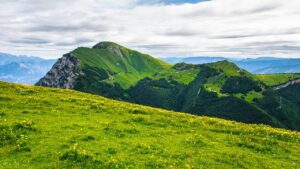
Near Gravina is Matera, also a UNESCO World Heritage site. Renowned for the old cave dwellings called “Sassi di Matera,” the city is also one of the world’s oldest continuously inhabited cities. Rock churches, stone roads, and Matera cave houses turn the city into a fairy-tale city to explore. It has even been utilized as a setting for some movies, such as The Passion of the Christ.
Bari
Regional capital city Bari is about 80 kilometers from Castel del Monte. It’s a ports city with history and culture in abundance. The Basilica of Saint Nicholas, which is a significant pilgrimage site, is where the saint, who was Santa Claus, is buried. The old town, Bari Vecchia, has narrow streets, home bakeries, and family trattorias. Visitors can enjoy the famous orecchiette pasta, which is made by street women.
Alberobello (Trulli Houses)
A bit further afield but well worth a visit is Alberobello, famous for its Trulli houses — whitewashed, cone-shaped stone buildings that appear to have leaped off the pages of a fairytale. A UNESCO World Heritage Site, Alberobello is one of Italy’s most unusual architectural wonders. Walking around Alberobello is like walking into a fairytale. The souvenir boutiques and local cafes add to the loveliness of this tranquil village.
Conclusion
Castel del Monte is not just a castle; it is a symbol of knowledge, enigma, and equilibrium. Its wise builder was the visionary Emperor Frederick II, and it is one of the greatest Middle Ages architectural miracles ever created. Its heavenly octagonal perfection, mathematical beauty, and esoteric symbolism still intrigue historians and visitors all over the world. Surrounded by beautiful towns, rolling hills, and azure Adriatic seas, Castel del Monte is a journey back in history, art, and nature. Whether you come for its mystery, its architecture, or its breathtaking vistas, this castle will amaze and inspire you — a true treasure of Italy’s heritage.

